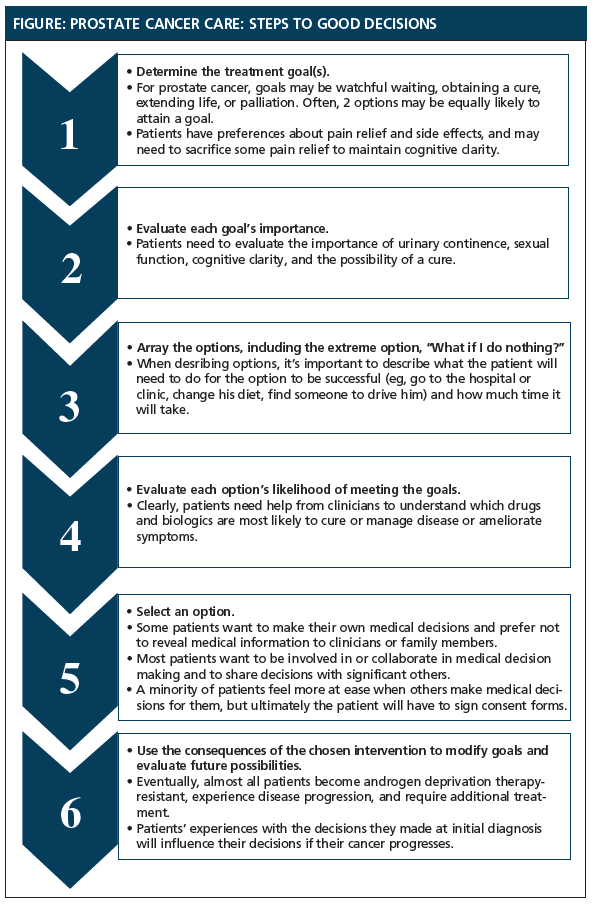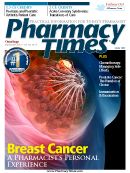Publication
Article
Pharmacy Times
Prostate Cancer: The Paradox of Choice
Author(s):
For patients, having many treatment options can add to the stress of a cancer diagnosis.
For patients, having many treatment options can add to the stress of a cancer diagnosis.
This article is about a disease that every man who lives long enough is expected to develop: prostate cancer. The article title is adapted from American psychologist Barry Schwartz’s book The Paradox of Choice: Why More Is Less. In it, Schwartz argues that the burgeoning number of consumer choices creates anxiety. His theory is that Americans face too many choices, and their aggregation often causes stress.1
What does choice (and stress) have to do with prostate cancer? Several traditional treatment options (eg, androgen deprivation therapies for simple disease; chemotherapy with docetaxel for metastatic cancer) were steadfast, equally effective options for decades. Today, newer, and often easier to administer, agents are available to treat prostate cancer or its most troublesome comorbidities (Online Table 12-6).2 These include sipuleucel- T (Provenge, Dendreon), denosumab (Xgeva, Amgen), abiraterone (Zytiga, Janssen Biotech), cabazitaxel (Jevtana, Sanofi-Aventis), enzalutamide (Xtandi, Astellas), and radium Ra 223 dichloride (Xofigo, Bayer/Algeta). Patients often find the process of selecting a treatment path stressful when many treatment options exist.3 How can pharmacists help?
Table 1: Prostate Cancer Treatment Options
Therapy
Examples
Side Effects/Notes
Androgen deprivation therapy
Surgical intervention
â–ª Removal of the prostate, usually by radical prostatectomy
â–ª Urinary or fecal incontinence, erectile dysfunction, loss of fertility, pain, lymphedema, change in penis length
Pharmaceutical intervention with gonadotropin-releasing hormone analogues
· Goserelin acetate
· Histrelin
· Leuprolide
· Triptorelin
â–ª Indirect prevention of testosterone production by the testes
â–ª Most common adverse effects include hot flashes, sexual dysfunction, and decreased erection
â–ª Transient increases in the serum testosterone level that can worsen cancer signs and symptoms
Oral antiandrogens (in combination therapy with a luteinizing hormone—releasing hormone analogue)
· Bicalutamide
· Nilutamide
· Flutamide
· Enzalutamide (new)
â–ª Direct blockage of androgens at androgen receptors
â–ª Most common adverse effects (>10%) include hot flashes, dizziness, abdominal pain, constipation, diarrhea, elevated liver enzymes, nausea, hematuria, nocturia, peripheral edema, back/bone/generalized pain, dyspnea, anemia, infection
Miscellaneous antiandrogen therapy:
· High-dose ketoconazole
â–ª Prevention of androgen production by adrenal glands
â–ª Weakness, gastrointestinal complaints, liver toxicity, skin reactions, and potential adrenal suppression
Chemotherapy for castrate-resistant prostate cancer
â–ª Mitoxantrone in combination with corticosteroids
â–ª Docetaxel in combination with prednisone
â–ª Cabazitaxel (new) in combination with prednisone for treatment of patients with hormone-refractory metastatic prostate cancer previously treated with a docetaxel-containing treatment regimen
â–ª Docetaxel: nausea, hair loss, bone marrow suppression, peripheral neuropathy (commonly presenting as temporary or persistent numbness, tingling, weakness in extremities)
â–ª Cabazitaxel: neutropenia, anemia, leukopenia, thrombocytopenia, diarrhea, fatigue, nausea, vomiting, constipation, asthenia, abdominal pain, hematuria, back pain, anorexia, peripheral neuropathy, pyrexia, dyspnea, dysgeusia, cough, arthralgia, and alopecia
Immunotherapy
Sipuleucel-T after bone metastases
â–ª Created from the patient’s own immune cells, which are collected by leukapheresis approximately 3 days before each scheduled infusion
â–ª May cause chills, fatigue, fever, back pain, nausea, joint ache, and headache
Radiopharmaceuticals
Radium-223 dichloride
â–ª Radium-223 has a structure similar to calcium, and bone processes it as it does calcium
â–ª Often causes nausea, diarrhea, vomiting
â–ª Administered at approved facilities
â–ª Common side effects include nausea, diarrhea, and peripheral edema; may also cause anemia, lymphocytopenia, leukopenia, thrombocytopenia, and neutropenia
Adapted from references 4-6.
Pharmacists need to remember 2 facts about prostate cancer. First, men are living longer not only in general but also with prostate cancer, especially if they enroll in clinical trials.7 Second, pharmaceutical manufacturers have about 400 products in active development for prostate cancer; while most will not navigate phase 3 trials successfully, those that do promise to be costly blockbusters.8 Thus, choices will increase, so pharmacists need to watch for new products and note their specific indications.
Faced with Choice

Schwartz describes how the best decisions are made (Figure1,3,9,10). When prostate cancer patients are faced with treatment choices, their medical, surgical, or radiation oncologists or urologists will map options for them and discuss the risks and benefits of each. Most practitioners who treat cancer rely on guidelines to keep up with evidence-based recommendations (Online Table 2). For prostate cancer, the gold standard is the National Comprehensive Cancer Network (NCCN) guidelines, which are available free of charge after registration at nccn.org. NCCN updated its prostate cancer guidelines in April 2014 and is remarkably adept at keeping them current.9 Pharmacists may find that quickly reviewing the summary of changes in each new issuance can be helpful. NCCN Guidelines for Patients, also free at www.nccn.org/ patients/guidelines/prostate/index.html#1, can help patients understand their disease, identify questions they may want to ask, and make informed choices.
Table 2: Guidelines for Prostate Cancer Screening and Treatment
· Carter HB, Albertsen PC, Barry MJ, et al. Early detection of prostate cancer: AUA guideline. Linthicum, MD: American Urological Association Education and Research, Inc; 2013. http://www.guideline.gov/content.aspx?id=46426&search=prostate+cancer+and+treatment.
· Qaseem A, Barry MJ, Denberg TD, Owens DK, Shekelle P. Screening for prostate cancer: a guidance statement from the Clinical Guidelines Committee of the American College of Physicians. Ann Intern Med. 2013;158:761-769. www.guideline.gov/content.aspx?id=45309&search=prostate+cancer+and+treatment.
· Cookson MS, Roth BJ, Dahm P, et al. Castration-resistant prostate cancer: AUA guideline. Linthicum, MD: American Urological Association Education and Research, Inc; 2013. www.guideline.gov/content.aspx?id=46425&search=prostate+cancer+and+treatment.
· Heidenreich A, Bastian PJ, Bellmunt J, et al. Guidelines on prostate cancer. Arnhem, The Netherlands: European Association of Urology (EAU); 2013. www.guideline.gov/content.aspx?id=45320&search=prostate+cancer+and+treatment.
Proven Paths
Community and institutional pharmacists dispense traditional agents and counsel patients about expected adverse effects. Androgen deprivation therapy (ADT) remains the first-line treatment for most prostate cancers. If a prostate cancer progresses, it is classified as castrate-resistant prostate cancer (CRPC) and patients will need to consider different treatment approaches.11
Specialty pharmaceuticals provide several options for treating advanced CRPC. First, abiraterone is approved for metastatic CRPC (mCRPC) in combination with prednisone with or without previous docetaxel therapy. This oral androgen biosynthesis inhibitor is taken once daily. mCRPC inhibits CYP17, a key enzyme responsible for androgen synthesis.11 A second oral specialty product, enzalutamide, is an androgen-receptor inhibitor indicated only for mCRPC patients previously treated with docetaxel. Its probable mechanism of action is competitive inhibition of androgen receptors, which decreases prostatic tumor volume and proliferation.12,13
The revised NCCN prostate guidelines indicate that abiraterone and enzalutamide appear beneficial in treating symptomatic patients who have mCRPC after receiving docetaxel. This is not a clinical trial finding, but it is an expert observation and consensus that both drugs palliate pain. The NCCN guidelines also recommend radium-223 dichloride as first-line and second-line options for patients with symptomatic bone metastases and no known visceral disease.9
Researchers are actively investigating ADT’s optimal timing, duration, and schedule, mainly to determine if they can reduce side effect profiles and improve men’s quality of life. Oncologists are prescribing intermittent administration more often. The NCCN guidelines say, “Men who choose ADT should consider intermittent ADT. A phase 3 trial . . . showed that intermittent ADT was not inferior to continuous ADT with respect to survival, and quality of life was better for the intermittent ADT arm.” Clinicians need to monitor prostate-specific antigen and testosterone levels closely when using intermittent ADT, especially during off-treatment periods. If disease progression occurs, patients may need to switch to continuous ADT.9
Endnote
Schwartz reminds us that choosing is not the same as choosing wisely. As people who develop cancer have more choices, their choices, in Schwartz’s words, “become grave burdens.” He says that people need to learn to be selective about exercising choice and to rely on experts when appropriate. Choices about prostate cancer care can be stressful for patients. More does not have to be less. Pharmacists can help.
Ms. Wick worked at the National Cancer Institute for 7 years. She is currently a visiting professor at the University of Connecticut School of Pharmacy.
References
1. Schwartz B. The Paradox of Choice. New York, NY: HarperCollins; 2004.
2. Wick JY. New therapies for prostate cancer: the practicalities. www.onclive.com/publications/urologists-in-cancer-care/2012/May-2012/New-Therapies-for-Prostate-Cancer-The-Practicalities. Accessed June 22, 2014.
3. Gwede CK, Pow-Sang J, Seigne J, et al. Treatment decision-making strategies and influences in patients with localized prostate carcinoma. Cancer. 2005;104:1381-1390.
4. Dorff TB, Glode LM. Current role of neoadjuvant and adjuvant systemic therapy for high-risk localized prostate cancer. Curr Opin Urol. 2013;23:366-371.
5. Surgery for prostate cancer. American Cancer Society website. www.cancer.org/cancer/prostatecancer/detailedguide/prostate-cancer-treating-surgery. Accessed June 22, 2014.
6. American Cancer Society. Hormone (androgen deprivation) therapy for prostate cancer. www.cancer.org/cancer/prostatecancer/detailedguide/prostate-cancer-treating-hormone-therapy. Accessed June 22, 2014.
7. Prostate cancer UK. Men with advanced prostate cancer living longer. http://prostatecanceruk.org/news/2013/10/men-with-advanced-prostate-cancer-living-longer. Accessed June 22, 2014.
8. Prostate cancer market to nearly double by 2019. National Association of Specialty Pharmacy website. www.nasprx.org/news/news.asp?id=146666. Accessed June 26, 2014.
9. Prostate cancer, Version 2.2014, April 2014. National Comprehensive Cancer Network website. www.nccn.org/professionals/physician_gls/pdf/prostate.pdf. Accessed July 1, 2014.
10. Prostate cancer, NCCN guidelines for patients. Version 1.2014, January 2014. National Comprehensive Cancer Network website. www.nccn.org/patients/guidelines/prostate/index.html#2. Accessed July 1, 2014.
11. MacVicar GR, Hussain MH. Emerging therapies in metastatic castration-sensitive and castration-resistant prostate cancer. Curr Opin Oncol. 2013;25:252-260.
12. Abiraterone acetate: drug facts and comparisons. Facts & Comparisons [online database]. St. Louis, MO: Wolters Kluwer Health, Inc; July 2011. Accessed June 27, 2014.
13. Enzalutamide: drug facts and comparisons. Facts & Comparisons [online database]. St. Louis, MO: Wolters Kluwer Health, Inc; July 2011. Accessed June 27, 2014.






